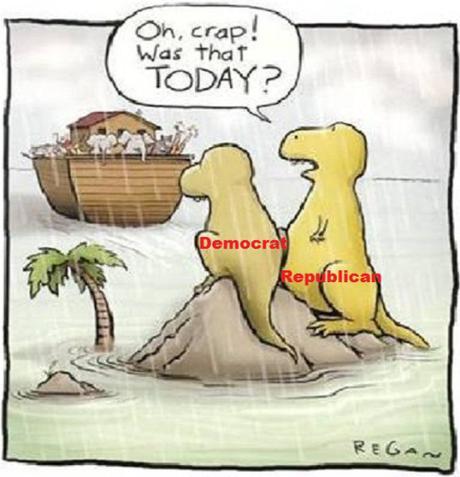Political parties serve important functions by aggregating or bringing together people of common interests, developing policies favorable to those interests, organizing their supporters and persuading voters to elect their candidates to political office.
The United States of America historically has been a two-party system, but there is a seismic shift going on, the implications of which are unclear and, therefore, troubling.
A recent Gallup Poll found that Americans who identify themselves as Democrats or Republicans are at all time lows: 29% Democrats; 26% Republicans. Both groups are now dwarfed by Americans who identify themselves as non-partisan Independents — a whopping 42%.

The changing party identification is indicative of many Americans having become profoundly disaffected and alienated from the two parties, and for good reasons. (See “America’s Bipartisan Ruling Class vs. the People“)
But their disaffection is also being expressed in their political apathy — increasing numbers of Americans are not voting. All of which augurs that we have entered a period of political upheavals and uncertainties.
Below are excerpts from David Lightman’s “At start of campaign, the last gasp of political parties,” in McClatchyDC, Jan. 28, 2016. My criticism of Lightman is that he himself is an exemplar of dinosaur Democrats: He highlighted only the Koch brothers as “big-money interests,” but omitted the “big-money interests” on the Left, such as George Soros and Michael Bloomberg.
As the nation begins the process of electing a new president, the roles of the Republican and Democratic parties are undergoing fundamental shifts that are threatening their impact on both elections and policy.
Built in the 19th century, grown dominant in the 20th, they are largely out of date in this new age.
They still control the ballot and machinery such as the primaries. But they do not hold the loyalty of the people. The largest party in America now is no party — with the ranks of people calling themselves independents at the highest level in more than 75 years of polling. The parties do not control the message. People learn about politics from social media instead of traditional means such as mailings or campaign rallies. And the parties are no longer the sole banker of politics. Big-money interests now effectively create shadow parties with extensive networks of donors of their own.
The result: People are tuning out and turning away.
In 2012, average voter turnout for statewide primaries for president, governor and U.S. Senate plunged to its lowest level since the modern primary system became popular in 1972.…
It’s a historic change in voter behavior….
Most indifferent to parties: young Americans. Nearly half the millennials identified as independents in 2014, Pew found, more than the combined total of those willing to be called either Democrats or Republicans….
Historically, children adopted their parents’ political views, including identification with the two major parties. Not anymore.
Millennials get information from sources other than from family dinners, neighbors or campaign brochures. If something piques their interest, they turn to Twitter, text messaging, The Skimm and other modern forms of instant communication….
Political parties are seen as too narrowly focused, too interested in keeping incumbents in office.
They gerrymander congressional districts to maximize their chances so that election after election only a handful of House of Representatives races are true contests. Of the House’s 435 seats, 402 incumbents are considered safe bets for re-election this year, said the nonpartisan Rothenberg & Gonzales Political Report.
Those safely partisan seats help keep Washington gridlocked — and turn off more Americans….
While independents are gaining clout, so are the big-money groups that now operate as virtual political parties.
Take Freedom Partners, an organization sponsored by brothers Charles and David Koch of Wichita, Kan.
Last year, the group committed to spend $889 million on politics and policy in 2015 and 2016.
The total would surpass the $404 million spent by the Republican National Committee and the $319 million spent by the Democratic National Committee in the 2012 campaign, according to opensecrets.org, which monitors political spending.
And that total would rival the $1 billion spent by all three major Democratic Party committees and the $1 billion spent by all three major Republican Party committees.
And the Koch network does more than just spend money. Twice each year it hosts about 400 executives, who pay dues of $100,000 each, for meetings on politics and policies. And its spending goes beyond the planned $250 million to help candidates, to include grants to organizations to help promote small-government policies as well as college scholarships and fellowships.
Other alternatives to the parties also are gearing up….
As Peter White, a cabin manager in Nottingham, New Hampshire, put it, “You feel the two parties both work for Wall Street and don’t care who wins.”
~Eowyn

